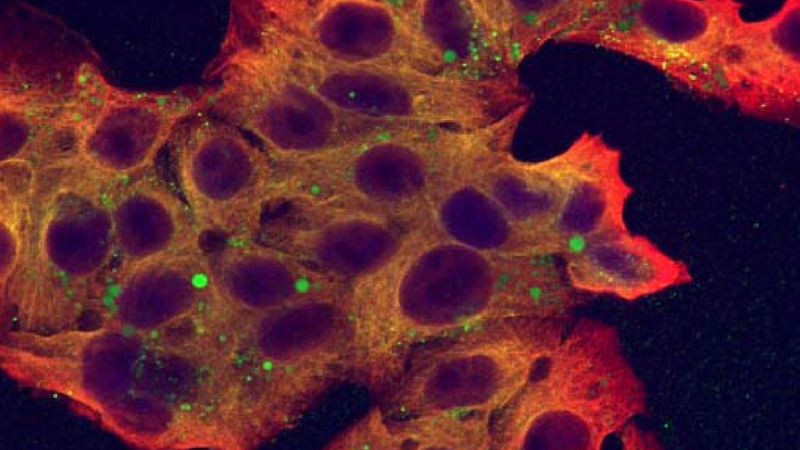A better understanding of nanomaterials

In the past six years, the National Research Programme "Opportunities and Risks of Nanomaterials" (NRP 64) intensively studied the development, use, behaviour and degradation of engineered nanomaterials, including their impact on humans and on the environment.
Twenty-three research projects on biomedicine, the environment, energy, construction materials and food demonstrated the enormous potential of engineered nanoparticles for numerous applications in industry and medicine. Thanks to these projects we now know a great deal more about the risks associated with nanomaterials and are therefore able to more accurately determine where and how they can be safely used.
"One of the specified criteria in the programme was that every project had to examine both the opportunities and the risks, and in some cases this was a major challenge for the researchers," explains Peter Gehr, President of the NRP 64 Steering Committee.
One development that is nearing industrial application concerns a building material strengthened with nanocellulose that can be used to produce a strong but lightweight insulation material. Successful research was also carried out in the area of energy, where the aim was to find a way to make lithium-ion batteries safer and more efficient.
Promising outlook for nanomedicine
A great deal of potential is predicted for the field of nanomedicine. Nine of the 23 projects in NRP 64 focused on biomedical applications of nanoparticles. These include their use for drug delivery, for example in the fight against viruses, or as immune modulators in a vaccine against asthma. Another promising application concerns the use of nanomagnets for filtering out harmful metallic substances from the blood. One of the projects demonstrated that certain nanoparticles can penetrate the placenta barrier, which points to potential new therapy options. The potential of cartilage and bone substitute materials based on nanocellulose or nanofibres was also studied.
The examination of potential health risks was the focus of NRP 64. A number of projects examined what happens when nanoparticles are inhaled, while two focused on ingestion. One of these investigated whether the human gut is able to absorb iron more efficiently if it is administered in the form of iron nanoparticles in a food additive, while the other studied silicon nanoparticles as they occur in powdered condiments. It was ascertained that further studies will be required in order to determine the doses that can be used without risking an inflammatory reaction in the gut.
What happens to engineered nanomaterials in the environment?
The aim of the seven projects focusing on environmental impact was to gain a better understanding of the toxicity of nanomaterials and their degradability, stability and accumulation in the environment and in biological systems. Here, the research teams monitored how engineered nanoparticles disseminate along their lifecycle, and where they end up or how they can be discarded.
One of the projects established that 95 per cent of silver nanoparticles that are washed out of textiles are collected in sewage treatment plants, while the remaining particles end up in sewage sludge, which in Switzerland is incinerated. In another project a measurement device was developed to determine how aquatic microorganisms react when they come into contact with nanoparticles.
Applying results and making them available to industry
"The findings of the NRP 64 projects form the basis for a safe application of nanomaterials," says Christoph Studer from the Federal Office of Public Health. "It has become apparent that regulatory instruments such as testing guidelines will have to be adapted at both national and international level." Studer has been closely monitoring the research programme in his capacity as the Swiss government's representative in NRP 64. In this context, the precautionary matrix developed by the government is an important instrument by means of which companies can systematically assess the risks associated with the use of nanomaterials in their production processes.
The importance of standardised characterisation and evaluation of engineered nanomaterials was highlighted by the close cooperation among researchers in the programme. "The research network that was built up in the framework of NRP 64 is functioning smoothly and needs to be further nurtured," says Professor Bernd Nowack from Empa, who headed one of the 23 projects.
The results of NRP 64 show that new key technologies such as the use of nanomaterials need to be closely monitored through basic research due to the lack of data on its long-term effects. As Peter Gehr points out, "We now know a lot more about the risks of nanomaterials and how to keep them under control. However, we need to conduct additional research to learn what happens when humans and the environment are exposed to engineered nanoparticles over longer periods, or what happens a long time after a one-off exposure."
National Research Programme NRP 64 "Opportunities and Risks of Nanomaterials"
The 23 NRP 64 research projects were launched in 2010 with a budget of 12 million Swiss francs. The objectives were to increase scientific knowledge relating to engineered nanomaterials and develop tools to maximise their benefits and minimise their risks to humans and the environment. At the same time, the NRP aimed at enhancing professional expertise and at providing decision-makers, manufacturers, distributors and consumers with detailed information. More than 100 researchers published around 150 scientific papers in the course of the programme. Annual progress report meetings were held and two interdisciplinary training courses for young scientists were organised in order to strengthen the research network.





